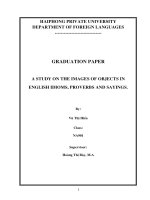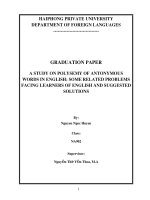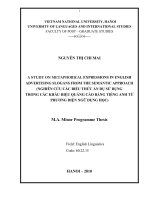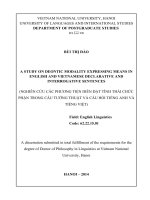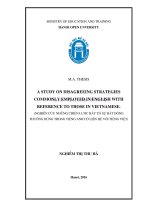A STUDY ON DEONTIC MODALITY EXPRESSING MEANS IN ENGLISH AND VIETNAMESE DECLARATIVE AND INTERROGATIVE SENTENCES NGHIÊN cứu các PHƯƠNG TIỆN DIỂN đạt TÌNH THÁI CHỨC PHẬN TRONG c
Bạn đang xem bản rút gọn của tài liệu. Xem và tải ngay bản đầy đủ của tài liệu tại đây (599.53 KB, 33 trang )
VIETNAM NATIONAL UNIVERSITY, HANOI
UNIVERSITY OF LANGUAGES AND INTERNATIONAL STUDIES
(NGHIÊN CỨU CÁC PHƯƠNG TIỆN DIỂN ĐẠT TÌNH THÁI CHỨC
PHẬN TRONG CÂU TƯỜNG THUẬT VÀ CÂU HỎI TIẾNG ANH VÀ
TIẾNG VIỆT)
!"# !$"%&"
'()*))*+,*-+
A dissertation submitted in total fulfillment of the requirements for the
degree of Doctor of Philosophy in Linguistics at Vietnam National
University, Hanoi
.)-+/
VIETNAM NATIONAL UNIVERSITY, HANOI
UNIVERSITY OF LANGUAGES AND INTERNATIONAL STUDIES
(NGHIÊN CỨU CÁC PHƯƠNG TIỆN DIỂN ĐẠT TÌNH THÁI CHỨC
PHẬN TRONG CÂU TƯỜNG THUẬT VÀ CÂU HỎI TIẾNG ANH VÀ
TIẾNG VIỆT)
!"# !$"%&"
'()*))*+,*-+
A dissertation submitted in total fulfillment of the requirements for the
degree of Doctor of Philosophy in Linguistics at Vietnam National
University, Hanoi
$012"'1"+*1'3*1*14 5$6 #
)*1*!$78 9&'6%
.)-+/
+* :&;!1'$ %'%#"%$7
Modality as an important component of linguistics has been extensively
studied from syntactic, grammatical, semantic and pragmatic
perspectives. The study of modality expressions within linguistics is one
of the complicated problems. As Palmer (2003: 4) says “modality is
realized by linguistic terms from a wide range of grammatical classes,
covering not only modal auxiliaries and lexical verbs, but also nouns,
adjectives, adverbs, idioms, particles, mood, and prosody in speech.”
There are three types of modality that can be distinguished in the modal
system of English. i.e., epistemic, deontic and dynamic that can be
interpreted in terms of possibility and necessity (Palmer, 2003: 7). This
research will focus on one important type of modality i.e. ' %&
<':%7. The term deontic modality “is a cover term for a range of
semantic notions such as ability, possibility, hypotheticality, obligation,
and imperatives” (van der Auwera & Plungian, 1998: 81). In Vietnamese,
deontic modality is rendered as “%= # %#> 	& 0#? @ A6' !#B:”
(Nguyễn Văn Hiệp, 2008: 103) which denotes obligations, duties,
necessity and the need for actions which is also chosen as the working
definition for this research.
A large number of studies have focused on theories of modality in general
and deontic modality in particular such as the works by Chung &
Temberlake (1985), Palmer (1979, 1986, 1990, 1994, 2003, 2004, 2005),
Lyons (1977), van der Auwera & Plungian (1998), (Wymann, 1994), and
1
(Li, 2004). In Vietnam, many scholars have also studied modality in
general and types of modality in particular such as Nguyễn Thị Lương
(1996), Cao Xuân Hạo (1999), Nguyễn Văn Hiệp (2001, 2008), Ngũ
Thiện Hùng (2003), Phạm Thị Ly (2003), Nguyễn Thị Cẩm Thanh
(2003), Bùi Trọng Ngoãn (2004), Võ Đại Quang (2009).
However, no attempt has been made to conduct a contrastive study on
linguistic means of indicating deontic modality in English and
Vietnamese. Therefore, this study is carried out to address that research
gap in order to provide a more articulate insight into similarities and
differences of deontic expressing means in the two languages, and to
serve as a framework for implicational purposes, which can be both
theoretical and practical.
)*<'3%#"%$7
This study is aimed at finding the similarities and differences in deontic
expressing means in English and Vietnamese. In order to achieve the
proposed aim, the objectives of the study are set as follows:
- To analyze and describe linguistic means of expressing deontic modality
in English and Vietnamese.
- To compare and contrast linguistic means of expressing deontic
modality in terms of grammatical and lexical features and frequencies
of usage in expressing deontic meanings in English and Vietnamese.
To achieve the above objectives, the following research questions are to
be addressed:
2
(i) What are the linguistic means of expressing deontic modality in
English and in Vietnamese?
(ii) What are the similarities and differences in linguistic means used in
the three types of deontic modality in terms of the syntactic and
semantic features and the frequencies of usage in English and
Vietnamese?
C*&'0'3%#"%$7
This study is focused on the descriptive account of syntactic and semantic
features of linguistic means of indicating three types of deontic modality
in English and Vietnamese based on the classification of Palmer (1994).
They are commissives, directives and volitives with the seven sub-types of
directives (deliberatives, imperatives, jussives, obligatives, permissives,
precatives, prohibitives) and the two sub-types of volitives (imprecatives
and optatives).
Modality is realized either by lexical or semantic means such as modal
auxiliaries, adverbs, adjectives, nouns, modal words, particles, etc. In
terms of syntactic and semantic features, the author will describe and
analyze deontic expressing means in English and Vietnamese i.e. modal
auxiliaries, hedge verbs, performative verbs, modal words, adverbs,
adjectives, nouns, particles, modal idioms, expletives, and modal
conditionals.
In English, mood (indicative, imperative, interrogative … moods) is an
important means of expressing deontic modality. It also means that, to
3
some extent, sentence types including the declaratives and interrogatives
can also be considered means of expressing modality in general and
deontic modality in particular. Therefore, the main focus of this thesis is
not on comparing and contrasting how linguistic means of expressing
deontic modality operate in the two sentence types: declaratives vs
interrogatives. Declarative and interrogative sentences are then used to
provide samples of linguistic means used within these two sentence types.
In this study, the main criteria to recognize declarative and interrogative
sentences in English are based on the theory of Palmer (1986: 26- 30).
The criteria to recognize declaratives and interrogatives in Vietnamese are
based on the work of Cao Xuân Hạo (1991: 128).
In this thesis, the author compares and contrasts deontic expressing means
taken from 421 declarative and interrogative sentences found in 50
English stories and 422 declarative and interrogative sentences found in
50 Vietnamese stories.
/*%#'''!7
/*+*%#'"'3%#"%$7
According to Saville-Troike (1982), one of the best methods of getting to
know one’s own “ways of speaking” is by comparing and contrasting
with those of others. This process will reveal the shared and unshared
features of linguistic patterns and their meanings. Thus, contrastive
linguistics with its associated research method – Contrastive analysis
(CA) - will be used as the primary research framework for this study.
4
For the comparison of the frequencies of usage in the two languages
under study, a quantitative analysis of the corpus is adopted. Corpus based
methods prove to be very effective in cross-language comparative study.
It allows us to access to a large sample of texts and compare various
syntactic as well as semantic features and frequencies of usage. Therefore,
corpus based method is also used in this study for comparative and
contrastive purposes.
/*)*:%:&'&%' 01'&$1"
/*)*+*"&10%' '3&'10$"
The corpora used in this study are built on the following general
principles regarding size, number of languages, sources : (i) #"D'3
%#&'10$": The two corpora used in this research consist of 50 English
stories, a total of 2060389 words and 50 Vietnamese stories, a total of
2003486 words. (ii) # $<E1 '3 : !$:!": The corpus in this
research is considered as a bilingual corpus; hence it contains the two
languages: English and Vietnamese. (iii) #"'$1&"'3%#&'10$": The
stories in this research are taken from e-books of contemporary works on
different sources (see appendix A & B).
/*)*)*'10$"&'<0:%' 01'&$1
As clarified in details the eleven types of deontic linguistic means in the
theoretical framework, the author lists all the devices used in those means,
such as can, could, may, might, shall, will, etc. belonged to the first means
(modal auxiliaries); think, believe, know, etc. is the second means (hedge
5
verbs), etc. Then, the author uses a tool for doing lexical analysis named
TexSTAT-2 program. This program can show the string matching and the
concordance to count the frequency of a certain device in the whole 50
stories and also find related collocation of other words together with a
certain device in English or Vietnamese.
The corpus supplies the number of words in each means, in each category
of sorted devices and shows a general overview of the distribution of
modal linguistic means quickly and accurately so that the researcher can
extract all of the declaratives and interrogatives used in each means as
well as all of the means used in the stories. An illustrated example of a
means of modal auxiliary is shown in Fig. 1 and Fig. 2 below:
!*+*%1 !<:%&# !'3 %# !"#&'10$"
6
!*)*%1 !<:%&# !'3FG %#% :<"&'10$"
The results of data processing are stored in the database for sorting and
analyzing. From the corpus, the researcher can collect 378 declaratives
and 43 interrogatives expressing deontic meanings in 50 English stories
and 382 declaratives and 40 interrogatives conveying deontic expressions
in 50 Vietnamese stories.
/*C*:%:: :7""
/*C*+*"&1E !%#:%:
After extracting the data from the corpus, a descriptive method will be
used at first to exploit all means and expressions of deontic modality used
in English and Vietnamese declarative and interrogative sentences in
terms of categories in the theoretical framework. Basing on devices
processed in the corpus, the author distinguishes eleven means of deontic
modality within 421 declaratives and interrogatives in English and 422
declaratives and interrogatives in Vietnamese and then, categorizes them
at three different types of meanings: commissives, directives and volitives.
This type of analysis is emphasized throughout the contextual translation
in the stories with various types of illocutionary forces.
/*C*)*'<0:1 !%#%H'"'$1&"'3:%:
In this dissertation, a contrastive analysis is carried out together with a
qualitative analysis in the analytical framework and a quantitative analysis
from the corpus in an effort to understand how contextual variables of this
corpus may influence deontic modal expressions in order to determine the
7
similarities and differences of deontic expressing means used in English
and Vietnamese stories. To compare eleven means of deontic modality
with regards to the three types of meanings: commissives, directives and
volitives, the author takes the English language as the base language and
Vietnamese as the comparative language. The examples analyzed are
taken from declarative and interrogative sentences in English and
Vietnamese stories.
The statistical calculations are made and classified by the figures for each
pattern. The results in English are then compared to those in Vietnamese
basing on the computation of various percentages in the corpus. The
similarities or differences will be analysed in details with specific data
and then to indicate any conclusions.
,*%1$&%$1'3%#"%$7
Apart from the introduction and conclusion, the dissertation consists of
three chapters: # %1'$&%' presents the theoretical background,
aim, objectives, the scope, methods of the study. #:0%1' provides a
brief of previous research, the general concepts of modality and, the
specific framework of deontic modality. #:0%1%H' is concerned with a
detailed description and comparative analysis on commissives and
volitives in English and Vietnamese. #:0%1 %#1 explores the
similarities and differences of directives in English and Vietnamese. #
&' &$"' provides the summary of the results of the study with research
implications, contributions and suggestions for future research.
8
I
+*+*"%'1&:01"0&%2"'3<':%7
Like most of theoretically-based historical studies, modality has been
pursued from the perspectives of both semantic and grammatical theories
of linguistics. The term “modality” derives from the postclassical Latin
words modalitas or modus in more than one sense that was used by
scholars in the Middle Ages. The history of English modal auxiliaries in
general and of modality in particular had prestigious place in studies since
the nineteenth century such as the works of Chomsky (1957), Denison
(1993), Beninca and Poletto (1997) in Italian, Peyraube (1999) in
Chinese, Van der Auwera & Plungian (1998), Hopper and Traugott
(2003), Palmer (1979, 1986, 1990, 1994, 2003, 2005), Palmer &
Facchinetti (2003), Van der Auwera et al. (2009).
For non-western languages, Wymann (1994) surveys modal constructions
in Korean and Japanese. Li (2004) compares modality types in terms of
grammatical features, semantic functions, pragmatic variation, logical
representation, and diachronic development in English under a typological
perspectivein comparison with Chinese.
In Vietnamese, Nguyễn Thị Lương (1996) describes the uses of particles
in question with various illocutionary forces. Nguyễn Văn Hiệp (2001/
2008) explores the semantics and syntax of modality and sentences in
Vietnamese. He discusses theoretical issues relating to main types of
modality such as subjective and objective, deontic and epistemic
modality, factuality and non-factuality in general.
9
A contrastive investigation of linguistic means expressing epistemic
modality in English and Vietnamese is carried out by Ngũ Thiện Hùng
(2003). Phạm Thị Ly (2003) also provides a contrastive analysis on some
linguistic means of modality in Vietnamese with the reference to English
such as modal verbs, adverbs and particles. Nguyễn Thị Cẩm Thanh
(2003) also compares linguistic means of expressing non-factual modality
in English and Vietnamese. Bùi Trọng Ngoãn (2004) surveys the role of
modal verbs in Vietnamese such as cần, phải, nên, dám, đành, nỡ in
combination with sentence particles. Võ Đại Quang (2009) also conducts
a study on linguistic means of expressing modality in English and
Vietnamese in terms of semantic and syntactic features within various
types of modality.
So far, there has been no research exclusively focusing on the contrastive
study of linguistic means of expressing deontic modality in English and
Vietnamese. Thus, this dissertation is an attempt to meet such research
need. It is also the major contribution of this study at least at the
application level.
+*)*':%7
+*)*+*3 %' ": 331 %2H0' %"
Several linguists have different viewpoints of modality and use several
terms to distinguish types of modality such as the works of Halliday
(1970 a, b), Lyons (1977: 848, 452), Chung & Temberlake (1985: 25),
Palmer (1986, 2001: 1), Quirk et al. (1985: 219), Downing and Locke
(1995), Van der Auwera (2001: 1), Matthews (2005: 228). The definition
10
of modality applied in this study is used most widely, agreeing with the
view of Huddleston & Geoffrey(2002: 172) and Palmer (2003: 4):
“modality is as a category of meaning which, in the verbal system, is
grammaticalized by mood”.
Many different definitions and viewpoints of modality have been
mentioned in English. However, until now there have not been any
definitions of modality proposed in Vietnamese. According to Nguyễn
Văn Hiệp (2008: 86), most Vietnamese researchers set out definition of
modality basing on theory of modality in English, and most of them
define modality in Vietnamese from Lyons’ definition of modality (i.e.,
“quan điểm hoặc thái độ của người nói đối với mệnh đề mà câu nói biểu
thị hoặc các tình huống mà mệnh đề miêu tả” (the speaker’s opinion or
attitude towards the proposition that the sentence expresses or the
situation that the proposition describes.)
+*)*)*70"'3<':%7
A modality type is a set of modal meanings attributed to an identical
semantic basis. In the studies of modality, linguists have identified
epistemic modality, deontic modality (Lyons, 1977), dynamic modality
(Palmer, 1986, 2001, 1990), and agent-oriented modality (Bybee et al.,
1994), etc. The last two types of modality have been reformed and
renamed by van der Auwera & Plungian (1998) as participant-internal
modality and participant-external modality.
However, in this study the researcher has only focused on ' %&
<':%7. Thus, the author gives a brief discussion of the three main
11
types of modality that will be applied for this dissertation as following:
0"%<&J' %&J and 7 :<&. Vietnamese linguists propose three
main types of modality for Vietnamese as %= # %#> #? %#9&
(epistemic modality) and %= #%#>	&0#? @A6' !#B: (deontic
modality) and %= #%#>%16 !#$K ! (dynamic modality).
+*C*' %&<':%7
+*C*+*3 %' ": 2:1'$"2H0' %"
The term “' %&” is derived from the Greek word déon that means
“binding or duty.” (Li, 2004: 13). According to van der Auwera &
Plungian (1998: 81), the term deontic modality “is a cover term for a
range of semantic notions such as ability, possibility, hypothetically,
obligation, and imperative meaning”. Deontic modality, as Lyons (1977:
823) describes, “is concerned with the necessity or possibility of acts
performed by morally responsible agents”. According to Palmer (1986),
“deontic” is used in a wide sense to include those types of modality that
are characterized by Jespersen (1909) as “containing an element of will”.
Vietnamese linguists consider deontic modality based on Lyons’
definition: “deontic modality is concerned with the necessity or possibility
of atcs performed by morally responsible agents”. Discussing on deontic
modality in Vietnamese, Duffield (1999: 4-5) claims that it is
important to highlight one further distinction referring to the English
modal auxiliary can that can be understood in terms of deontic meanings
is that được/ được phép.
12
+*C*)*70"'3' %&<':%7
My choice has focused on the theoretical framework for classification of
deontic modality of Palmer (1994: 181) in English and Nguyễn Văn Hiệp
(2008: 77-79) in Vietnamese. i.e. &'<<""2"J2'%2" with the two
sub-types (<01&:%2" and '0%:%2"L, and 1&%2" with the seven
sub-types (E1:%2"J <01:%2"J M$""2"J 'E!:%2"J
01<""2"J01&:%2"and 01'#E%2"L
+*/*' %1:"%231:<H'1;
In order to compare and contrast different linguistic means of
expressing modal functions of three main types of deontic modality:
commissives, directives and volitives with their nine sub-types
identified above, the author bases on the typological studies and
classification of Palmer (1986, 2003), van der Auwera & Plungian
(1998), Li (2004), Nguyễn Văn Hiệp (2008), Bùi Trọng Ngoãn
(2004), and for the purpose of this research, the following thirteen
linguistic means are identified as main categories for comparison
between English and Vietnamese. However, due to the nature and
limitations of the data collection method, the prosodic element as an
important means of expressing modality has been left out, and
inflection/ mood is traditionally expressed in verbal morphology.
According to Palmer (1986: 21), mood is formally a
morphosyntactic category of the verb like tense and aspect, and
mood is a grammar category that is found in some, but not all,
languages. Vietnamese language is an isolated language, therefore it
does not include inflection/ mood. Thus, inflection and mood are
13
considered non-equivalences in Vietnamese. For this reason, the
eleven (out of a total of thirteen) linguistic means are identified as
main categories for comparison between English and Vietnamese in
terms of frequencies of usage: modal verbs, hedge verbs, performative
verbs, modal words, modal adverbs, modal adjectives, modal nouns,
particles, modal idioms, expletives, and modal conditionals.
)
This chapter is to identify, describe and contrast linguistic means of
expressing of the two types of deontic modality in English and
Vietnamese i.e. commissives and volitives, with particular focus on what
syntactic - semantic features of commissive and volitive expressions in
English and Vietnamese have in common and how they differ in terms of
semantic - syntactic features and the frequencies of occurrences.
Of the eleven means of expressing deontic modality as set from the
theoretical framework in Chapter one, only seven means of expressing
commissives in English (i.e. modal verbs, hedge verbs, performative
verbs, modal adverbs, modal adjectives, expletives, modal conditionals)
and three means of expressing commissives in Vietnamese (i.e. modal
verbs, performative verbs and modal conditionals) are used. In terms of
volitives, both in English and Vietnamese, only one means of linguistic
expressions (i.e. modal conditionals) is used. Examples for each means
14
are taken in declaratives and interrogatives in the two corpus including
100 stories in English and Vietnamese.
Based on the frequencies of lexical means in English, among 14583
devices of modal expressions, in English, declaratives and interrogatives
are normally used with 421 sentences in which commissives account for
79 sentences. Declaratives and interrogatives in Vietnamese are found at a
high frequency with 422 sentences in which commissives only account
for 11 sentences.
Most of the declaratives and interrogatives expressing commissives in
English, modal verbs are most-frequently used, with 70.89%. Hedge verbs
and modal conditionals are equally used with the same rate 7.59%. Both
modal adverbs and performative verbs rank third with 5.06%. Modal
adjectives are rarely used with 2.53%. The least frequency of commissive
expressing means is expletives, 1.27%. Modal words, modal nouns,
particles, and modal idioms are hardly used to express commissive
meanings. The distribution of English commissiveexpressing means is
shown in Fig. 2.13 below:
15
!*)*+C*"%1E$%' '3 !$"%&<: "'3N01"" !&'<<""2"
!"#
In Vietnamese, among 11 occurrences to express commissives, modal
verbs are the most normally used with 9 cases, ocuppying 81.82%.
Performative verbs and modal conditionals are fewer used, only 1 case
with 9.09%. The other expressing means are not used to express
commissives as seen from the distribution of Vietnamese commissives, as
illustrated in Fig. 2.14 as follows:
!*)*+/*"%1E$%' '3 !$"%&<: "'3N01"" !&'<<""2"
% :<"
It can be seen that a very common use in English and Vietnamese is that
the sense of shall and sẽ are used to denote a promise of doing something.
However, English speakers use more modal auxiliaries to express
commissive meanings, accounting for 56 cases with 70.89% of all
expressions. Vietnamese speakers only use 9 cases with 81.82%. Hedge
verbs and modal conditionals are less commonly used in English and
16
Vietnamese, only accounting for 6 cases with 7.59% for each expression
in English and only 1 case with 9.09% for each in Vietnamese. A clear
difference that has been seen in English and Vietnamese is that
performative verbs, modal adjectives, modal adverbs, expletives are used
in English, but they are not used in Vietnamese. These are shown in Fig.
2.15 below:
!*)*+,*' %1:"%2: :7""'3&'<<""2" !"#:
% :<"
In brief, as has been seen, a similarity of the two languages in the usage of
modal conditionals to express volitive meanings though Vietnamese only
use 6 cases ranking a tenth of 96.43% of using modal conditionals in
English, as displayed in Fig. 2.19 below:
17
!* )*+(* &' %1:"%2 : :7"" '3 2'%2" !"# :
% :<"
Fig. 2.19 shows that English and Vietnamese are similar in the use of
imprecatives that expresses misfortunes, as in the sentence: “Có lẽ bạn sẽ
thắng lần sau.” (Perhaps you'll win next time); or “có lẽ em không qua
được cơn đau này.” is equivalent with “I may not overcome this pain.”
Both English and Vietnamese express optative meanings through lexical
verbs wish, hope as shown in examples above. However, in Vietnamese,
there are various ways to express optatives such as mong/ cầu/ ước/ chúc
(from examples (2.48) to (2.54)) while in English, they only use wish/
hope to indicate optatives. This is a significant difference in the usage of
lexical means in English and Vietnamese.
In summary, this part has made a contrastive analysis on commissive and
volitive expressing means in English and Vietnamese. With respective to
syntactic features, English and Vietnamese modal verbs may occur in the
same syntactic environment or simply the same construction in the
declaratives to express commissives. However, in the interrogatives, in
English, the word order of the subject and the modals is the opposite of
that in Vietnamese. Hedge verbs in the declaratives in English are similar
to those in Vietnamese. In contrast, hedge verbs in the interrogatives in
English are different from those in Vietnamese.
Most of the performative verbs in Vietnamese constructions do not have
non-finite forms and they are not inflected in the third person singular of
the present tense. A clear difference between the two patterns of
18
performative verbs is that Vietnamese structures are normally used in
combination with a final particle while English structures are not used.
The constructions of modal adverbs and modal adjectives are different
from those in Vietnamese. Modal adverbs in English are normally
followed by a bare infinitive of the verb while modal adverbs in
Vietnamese are usually followed by a clause or a modal verb that modify
the whole sentence.
The expletive it in English can follow a verb and considered as an object
of the sentence while in Vietnamese expletives allow double verbs “A
1O:<P%Q, and its usage is considered an empty word “&#' R<>%”
referring to the situation in that utterance. English speaker is hardly used
the expletive like that. However, there is no significant difference
between modal conditionals in English and in Vietnamese except the
equivalent translation in Vietnamese S T$U%#=” compared with the
structure “3V&:$"JHVUQ in English.
Volitive constructions in English are also different from those in
Vietnamese. To express optative, in English, volitive structures are very
polyfunctional with a variety of patterns such as SH"#%'VQJS#'0%'
V Q '1 S H"# 7'$@ H1”, …. In Vietnamese, in contrast, only
attitudinal or intentional verbs such as “WX&!=J&#Y&, #2Z !,…” are
used to precede sentences.
With regard to semantic features, in English, the use of linguistic means
to express commissives covers deontic modal auxiliaries, hedge verbs,
modal adverbs, modal adjectives and modal conditionals.Vietnamese are
19
also similar to English in the usage of modal auxiliaries (will/shall and
sẽ), hedge verbs (think and nghĩ) and modal conditionals (if and nếu …thì)
to express a promise, a threat or a commitment. However, the occurrences
of modal auxiliaries, hedge verbs and modal conditionals expressed in
Vietnamese are used in low frequently in comparison with those in
English (9 cases compared with 56 cases in overall). This is also a clear
difference in the uses of commissive means in English and Vietnamese.
The above findings provide empirical evidence that English and
Vietnamese volitive expressing means share the same meaning in the
usage of optatives with hope and wish though Vietnamese speakers are
very polyfunctional in the usage of the words mong/ cầu/ ước/ chúc to
express a hope or a wish. However, English speakers use modal auxiliary
may not or adverb perhaps to express imprecative sense, Vietnamese
speakers use conditional sentences “nếu …thì” to express imprecatives.
This is a significant difference in the usage of means of expressing
volitives in English and Vietnamese.
C
This chapter presents a contrastive analysis of linguistic means of
expressing directives in English and Vietnamese. From the data provided
in the English and Vietnamese corpus, the author checks and clarifies the
directive expressing means consisting of modal verbs, hedge verbs,
performative verbs, modal words, adverbs, adjectives, nouns, particles,
modal idioms, expletives, and modal conditionals taken from 421
declaratives and interrogatives in 50 English stories and 422 declaratives
20
and interrogatives in 50 Vietnamese stories with the purpose to find out
the similarities and differences among them.
From the data illustrated in the study, we can conclude that, of 421
declaratives and interrogatives in 50 English stories, there are 282
declaratives and 32 interrogatives expressing directive means, in which
modal auxiliaries are the first highest frequently used, reaching over a half
of all (171 devices with 57.6%). Hedge verbs rank second position,
accounting for 44 cases with 14.01%. Performative verbs and modal
adverbs are nearly the same frequency, ranking third and fourth position,
accounting for 28 and 22 cases with 8.92% and 7.01% respectively.
Modal conditionals and modal adjectives are frequently used (4.46% and
4.78%). Modal idioms are less normally used of all in terms of directive
meanings (2.55%). Modal nouns are the least frequently used, only 2
cases (0.64%). Neither modal words nor expletives are used to express
directive meanings in English. The distribution of English directives is
displayed in Fig. 3.18 below:
!*C*+[*"%1E$%' '3 !$"%&<: "'3N01"" !1&%2"
!"#
21
In Vietnamese, 367 declaratives and 38 interrogatives of 422 sentences
are used in 50 Vietnamese stories to express directive expressing means.
Among these devices, particles are the highest frequently used, reaching
182 occurrences with 44.9% of all directive expressions. Modal words are
the second frequently used, accounting for 106 occurrences respectively
26.17%. Modal idioms are normally used in the third position (55 cases
with 13.58 %). Modal conditionals, modal adverbs, modal nouns are used
at the lowest rate, only accounting for 3 cases, 2 cases, and 1 case in turn.
Hedge verbs and modal adjectives are rarely used to express directive
meanings as displayed in Fig. 3.19 below:
!*C*+\*"%1E$%' '3 !$"%&<: "'3N01"" !1&%2"
% :<"
As can be seen, English speakers show a tendency towards modal
auxiliaries to express directive meanings with the highest frequency of all.
(171 cases with 57.6%). While Vietnamese speakers only use 25 cases of
modal auxiliaries expressing directive meanings, respectively 6.17%.
Hedge verbs, performative verbs, modal adverbs, modal conditionals,
modal adjectives are normally used in English, raking second, third and
22
fourth position of all directives means in English. In contrast, Vietnamese
speakers use particles, modal words and modal idioms with the highest
frequency of all conveying directive expressions, ranking first, second and
third of all while modal auxiliaries, performative verbs, modal
conditionals are less frequently used. Modal words and expletives are not
used to express directive meanings in English, whereas in Vietnamese,
hedge verbs and modal adjectives are not used. This is a considerable
difference between the two languages. A similarity is found between the
two languages that in both languages use modal nouns, only 2 cases in
English and 1 case in Vietnamese, with 0.64% and 0.25% respectively.
This is illustrated by Fig. 3.20 as following:
!*C*)-*&' %1:"%2: :7""'31&%2N01""' " !"#
: % :<"
To sum up, this part has set forth a contrastive analysis on syntactic -
semantic features of directive means in English and Vietnamese. We can
conclude that in terms of syntactic features, in English and Vietnamese,
the modal verbs combine with verbs such as “shall go” and “sẽ đi”. This
seems to be a similarity between English and Vietnamese. However, apart
23
